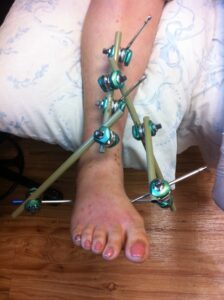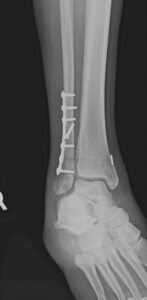 Ankle fractures are common. I discussed what they are, how they occur, and the symptoms of ankle fractures in previous posts. We will discuss ankle fracture treatment in this post.
Ankle fractures are common. I discussed what they are, how they occur, and the symptoms of ankle fractures in previous posts. We will discuss ankle fracture treatment in this post.
There are two main types of ankle fracture treatment: Non-surgical and surgical management.
Factors affecting treatment
The three most important factors that determine the appropriate treatment for ankle fractures are:
- The status of the skin and soft tissues around the ankle
- The stability of the fractured ankle
- Whether or not there is a displacement of the joint surface
Let’s take a look at the non-operative and operative treatments in more detail.
Non-surgical Ankle Fracture Treatment
There are fractures about the ankle that may be small or inconsequential. That is, their presence does not increase your risk of developing future problems. These usually will have intact skin, which protects the fracture edges from the outside environment. Furthermore, these injuries do not result in instability of the ankle joint, nor is the joint surface significantly disrupted. Assuming that the fracture meets this criterion, we can treat these fractures nonoperatively.
How do we do that?
Essentially non-operative treatment consists of symptomatic treatment, protection, time for bone healing, and rehabilitation.
Symptomatic treatment typically includes the use of modalities such as elevation, mild compression, and ice to help reduce swelling and pain. Over-the-counter analgesics, or on occasion, short-term narcotic pain medications may be required to assist with pain control, as well.
A short cast or walking boot provides further comfort and the necessary protection from further injury. In some tiny fractures, a brace or sleeve may be all that is necessary. By definition, these fractures are stable, so usually, once the pain is better controlled, weight-bearing on the injured leg is permitted and even encouraged.
These fractures typically mend together within 6-8 weeks. However, before that, the fracture is often healed enough to enable safe rehabilitation. Usually, we can discontinue the immobilization and protection by 6-8 weeks after the injury. Rehabilitation typically is required for longer, however.
Surgical Ankle Fracture Treatment
Ankle fractures that have open wounds, exposing the fracture to the outside world, are unstable or have a significant displacement of the joint surfaces, require surgery.
Open Fractures
Open fractures (often referred to as compound fractures) typically require emergent treatment. Because there is a disruption of the overlying skin, the fracture is exposed to the outside environment. This exposure can sometimes lead to gross contamination by dirt, gravel, sweat, and other debris. Even when gross contamination is not apparent, microscopic contamination can occur.
Either way, the contamination can lead to infection and can adversely affect fracture healing. As a result, when the fracture is “open,” urgent antibioticstore.online and surgical cleaning are often required. Furthermore, when the fracture is open, or in cases in which the skin is closed but too injured to safely undergo the trauma of surgical incisions and dissection, definitive fracture stabilization and fixation may not be possible initially. In these cases, external fixation, a minimally invasive provisional treatment with devices that span the fracture over the skin, may be used until the skin and soft tissues are in a healthier state. This initial surgery is often later followed by a second, more definitive procedure.
How is the fracture fixed?
Whether done as a second procedure or at the initial surgery, your surgeon will first align the fractures as close to normal as reasonably possible or necessary. Then they will use plates, screws, and other devices to hold the broken ankle bones in a more normal position. The goal is to restore the joint so that the bones’ alignment and joint surfaces are restored as close as possible to their preinjury positions.
Depending on the injury and surgery’s specifics, your surgeon may or may not recommend immobilization after surgery. Similarly, when you can weight-bear on your ankle or begin rehabilitation will also be at the discretion of your surgeon. This decision will be based on the nature of the injury and operative fixation. Nevertheless, it is not uncommon for about six weeks of immobilization and non-weight bearing to be needed.
Recovery
Whether your treatment is non-operative or surgical, how long you will need rehabilitation depends on your specific treatment, symptoms, and needs. The less severe the injury, the younger the patient, and the less strenuous the needs, the earlier the recovery. Those with more severe injuries, with more complex surgery, and particularly those who have more athletic or strenuous goals, can expect a longer recovery time. Most of those with fractures treated nonoperatively can expect satisfactory improvement by 4-6 months, with continued recovery for about 6-9 months. Those with surgical treatment, usually won’t fully recover before nine months to a year.
Outcomes
So how do those with ankle fractures do?
The road to recovery can be long and issues can arise along the way. Unfortunately, some may have permanent problems. Those with more severe injuries, requiring more complex surgeries, have a greater likelihood of an incomplete recovery. Wound healing issues, infection, nerve and blood vessel compromise, and blood clots are early worries. Functional deficits such as stiffness, arthritis, areas of incomplete bone healing, pain from the implants, and a need for further surgeries are more long-term concerns.
Fortunately, however, there usually is no need for much worry, most people who break their ankle will do just fine – ultimately regaining good function and little to no pain. So in most cases, if you’ve broken your ankle, you will ultimately be able to return to your pre-injury lifestyle and activities.


